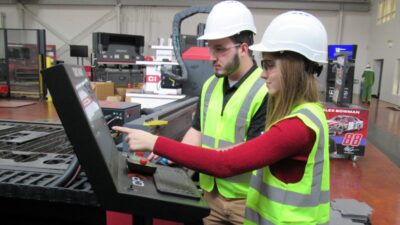Product proliferation and internationalization, along with demands and costs for shipping, maintenance, upgrades, and enhancements, will continue to encourage wider geographical distribution of manufacturing activities. In fact, many companies own process plants in more than one country. These facilities (typically owned through acquisition) generally bring with them disparate legacy automation...
Product proliferation and internationalization, along with demands and costs for shipping, maintenance, upgrades, and enhancements, will continue to encourage wider geographical distribution of manufacturing activities. In fact, many companies own process plants in more than one country. These facilities (typically owned through acquisition) generally bring with them disparate legacy automation environments that must be consolidated into a single, albeit heterogeneous, operation. Parallel efforts by engineering groups from different parts of a company demand coordination as well. An innovation at Mercedes, for example, may require incorporation into Daimler-Chrysler’s process design activities in the U.S. Coupled with design efforts that often occur far from production, effectively managing these environments represents a considerable challenge.
According to Siemens Energy and Automation, these trends require addressing several specific automation issues:
-
Companies must integrate existing legacy assets into a combined automation infrastructure.
-
The process must support multiple software and documentation languages.
-
Distributed engineering activities must permit centralized viewing and controlling of remote sites.
-
The entire process must encourage stronger ties and a common architecture across the automation spectrum, including safety concerns and information management.
Global impact
Various stages of the manufacturing process have experienced different degrees of globalization. Process design, for example, has remained relatively unaffected. Laboratories and pilot plants still furnish the necessary information and process parameters as a starting point for ramp-up to full production. Even here, however, change will come eventually. Rich Clark, hydrocarbon processing marketing manager, Honeywell Process Solutions, predicts that computer tools will replace pilot plants for verifying and adjusting process models. Making a “virtual plant” available to everyone on the corporate network will allow designers, process engineers, and users alike to tailor processes for each specific location, worldwide.
Clark suggests that globalization has exerted the largest influence on detail engineering—that is, translating process designs into actual production. Companies today often design initial processes, then distribute the accompanying work to low-cost centers around the world. Again, better collaboration between designers and end users will greatly simplify the iteration efforts required to bring location-specific process details into line with the original engineering specifications.
According to Clark, engineering support of manufacturing operations in real time will eventually see the most profound impact from globalization efforts. Concentration of expertise at a single location has already centralized initial troubleshooting activities. By collecting and analyzing the data there as well, a single person or one group of people can provide all necessary resources to optimize process performance or take corrective action. Although setting up networks to gather and analyze data has historically involved home-grown ad-hoc solutions, off-the-shelf alternatives are emerging. Companies like SigmaQuest have begun to offer tools that automatically collect data from all points in an organization and analyze the data according to a host of user-determined criteria, presenting a variety of reports. Such solutions are platform-independent, so the existence of legacy assets at the far reaches of the planet does not impede feedback, analysis, or control.
Advancing standards
| These charst detail the global hazardous location markings specific to the Canadian, European, and the U.S. standards. |
While globalization usually suggests a commonality of products and processes, sometimes the issue is exactly the opposite. Pepperl+Fuchs, for example, offers an array of intrinsic-safety products, providing explosion-protection in hazardous areas. Each of these products must have approval from a recognized agency, such as Underwriters Laboratories (UL) in the U.S. (See chart on p.22 for global standards markings.)
Although intrinsic safety requirements are similar, as yet there is no universal standard, so some products approved in one country would not meet the standard somewhere else. Europe divides hazardous areas into 3 classes. Zone 0 specifies that the hazardous condition (such as an explosion potential or hazardous vapor) is present all the time under normal conditions. In Zone 1, the hazard exists under normal conditions for more than a certain number of hours per year. Zone 2 signifies that the hazard is only present during abnormal conditions—such as a leaky ethylene or alcohol delivery system, which constitutes a fire hazard. The U.S. combines Zones 0 and 1 into Division 1. Division 2 generally corresponds to Zone 2. As a result, a process controller approved for Division 1 in the US would work in Zone 1 in Europe, but would not be approved for Zone 0. Mike McElroy, business-development manager at Pepperl+Fuchs, observes that U.S. approval agencies have begun harmonizing with their European counterparts, but such migration takes time.
For more information, see the Back to Basics article, “‘Division’ or ‘zone’ by any other name is still hazardous,” in the May 2003 issue of Control Engineering (accessible on the Web through our online archives at www.controleng.com ).
Necessity is the mother
Todd Walter, FieldPoint product manager, National Instruments (NI), contends that ever-increasing globalization is inevitable because of the high cost of not doing it. Proliferation of personal computers and other standard platforms has “democratized” the manufacturing process. An expert develops control algorithms at a central location, then distributes them to the field. The common PC-based environment ensures that implementing those algorithms requires merely following the procedures that the expert has laid out—an activity demanding much less experience. Ramp-up in the field may require tweaking the initial process, but rarely demands anything close to a redesign. And since an independent contractor generally performs the actual manufacturing (which may occur half a world away from the process design), such democratization has become not only a convenience, but an economic necessity. Most contract manufacturers can’t afford to shut down a production line while they await the customer’s expert. Travel time, lost production, missed commitments, and other consequences can evaporate already slim profit margins. And even companies that claim to manufacture their own products often set up separate operations logistically indistinguishable from a contractor approach.
According to Walter, a successful operation must develop products and processes that meet specification criteria from all countries in which they will be sold. In NI’s case, a data-acquisition board may begin its life at a facility in the U.S. As process control parameters become better understood and production ramps up, the company may transfer actual production to a facility in Hungary. To avoid revamping design or performance specifications, the company requires that the product already meet the needs of both countries and any others where it will be sold, including legacy manufacturing systems and retrofits, and must remain flexible enough to accommodate any unfamiliar situation that might arise.



